The online fitness industry will grow exponentially in the next ten years. Valued at just $14.9 billion in 2022, Allied Market Research reports the industry will balloon to a massive $250.7 billion valuation by 2032.
Demand for online fitness coaches is driven in part by a need for virtual fitness solutions but also by advancements in technology like AI software and health insurance providers’ interest in the industry.
Learning how to become an online fitness coach is a great way to enjoy more flexibility, reach a global clientele, reduce overhead, integrate new technology, and boost your work-life balance.
This step-by-step fitness coaching guide covers everything from building a strategy and designing your online training program to creating a successful launch.
Let’s get started!
Skip ahead:
-
What does an online fitness coach do?
How do online fitness coaches make money?
What does an online fitness coach do?
An online fitness coach is responsible for providing fitness instruction to clients via digital platforms like a website or mobile app. Coaches can leverage technology to track their clients’ progress, deliver feedback, share nutrition plans, and personalize fitness programs.
What qualifications do you need to be an online fitness coach?
Qualifications and skills for online fitness coaching vary based on your coaching method. Typically, coaches are required to hold a high school diploma at a minimum, while some gyms require a personal trainer certification or health coach certification.
However, the job of a fitness coach is not regulated by the law. This means you don’t need a specific certification or degree to become an online health and fitness coach.
Still, as an online fitness coach, a large part of your job is building a brand and marketing your business. The fitness industry is highly competitive. Continuously improving your skills and demonstrating your knowledge with certifications will give your business credibility and help you stand out from the competition.
How do online fitness coaches make money?
Online fitness coaches earn money from multiple sources. These income streams may include:
- One-on-one workouts
- Selling online fitness plans
- Social media sponsorships
- Marketing digital content
- Social media ad revenue
- Premium content
Let’s look at what each of these income opportunities are and how online fitness coaches can use them as an opportunity to earn money for their business.
One-on-one workouts
Let’s start with the obvious. Many online fitness coaches make the bulk of their income through traditional — albeit virtual — one-on-one workout sessions.
Many different arrangements can work for online training. You can, for example, coach your client over a video call while they work out in their home gym. Or, you can build custom workout plans for your clients and check in on their progress via calls or messages. Everything depends on your and your client’s individual preferences.
You would typically price virtual fitness coaching sessions per hour or per package.
Selling online fitness plans
Online fitness courses are the fastest way for fitness coaches to scale their businesses. Launching a successful course does require a smart pricing strategy and a bit of marketing, but it’s not rocket science—ultimately, what you’re sharing is your own expert knowledge.
Once you design and build a course that guides your audience through a workout or series of workouts, you can keep selling it for as long as it’s relevant. As you gain students, you’ll be able to tweak your fitness course, making it better and better with time.
Social media sponsorships
Gone are the days when you needed hundreds of thousands of followers to be an “influencer” and monetize your social accounts. Modern marketing recognizes the power of micro-influencers, people with followings between 1,000 and 100,000 on social media.
So whether you have a massive following already or you’re building as you build your business, social media sponsorships are a great revenue opportunity.
To get started, put together a pitch deck. It should include:
- Basic information about yourself and your fitness coaching business
- Your social media stats (number of followers, engagement rate, etc.)
- Information about your audience demographics
If you already have brands in your inbox, then you can use this pitch deck to negotiate your rates. If brands haven’t slid into your DMs just yet, don’t worry. Reach out to some brands you’d like to work with.
As you consider brands to connect with, look for brands who already partner with similar creators, creators with a similar following, follower count, engagement rate, or niche. Brands working with similar creators are clearly open to influencer marketing, making your chances of a partnership more likely.
In some cases, you might only get free products or services in exchange for a brand shoutout on your account, but more elaborate partnerships always involve monetary compensation.
To maintain your audience’s trust, make sure you only recommend brands and products you truly believe in. Also, always disclose sponsorships—it’s the law.
Marketing digital content
Fitness coaches with a reputation in the industry and/or a large social media following can also generate passive income through valuable digital content. Monetized digital content for online fitness coaches can include:
- Premium content, like Patreon and Instagram Subscriptions
- Ebooks
- Online courses
- Webinars and online workshops
- Nutrition plans
- Cookbooks
- Fitness templates
- Merchandise
- Personalized consultations
- Fitness retreats
While any of these digital content ideas are excellent monetizable assets, you can also leverage them as a free asset in a larger marketing funnel that drives followers, students, or customers to other monetized content.
In marketing, these free assets are often called lead magnets. In exchange for access to a high-value resource like a cookbook or fitness plan, clients provide an email. You can then use your email marketing skills to drive potential clients to higher-ticket services like an online course or a one-on-one coaching program.
Regardless of how you decide to implement digital content as an online fitness coach, it’s an invaluable asset for your business.
Related: 9 Simple Ebook Marketing Strategies (+Guide)
Social media ad revenue
While social media platforms like Instagram and TikTok are excellent at building a brand and a following, a platform like YouTube allows you to build an audience while monetizing your content at no cost to the viewer.
Once you meet YouTube’s monetization requirements, your training programs and content on the platform can start earning you ad revenue. There is no limit to what you can earn on the platform, so the amount of passive income you can generate relies entirely on your ability to grow an audience and foster engagement.
How to become an online fitness coach in 9 steps
If you’re ready to make the leap and become an online fitness coach, the steps outlined below will help you get set up for success. We’ve included instructions for building, marketing, and selling a self-guided virtual training program (but most of these tips also apply to one-on-one online personal training).
Step 1: Identify your niche
The first step in learning how to become an online health and fitness coach is narrowing your scope of work down to a specialization that:
- You excel in – Rather than trying to become something you’re not, focus on what makes you great. For example, if you have extraordinary results in helping clients lose weight, specialize in weight loss.
- Your target clients can benefit from – Your clients are ultimately why your business exists. This means helping them should be your number one priority. Set up a strong foundation by highlighting the needs of your client base in all of your content.
A common mistake many new coaches make is casting a wide net and marketing themselves as just a “fitness coach.” But by appealing to everyone, you’re likely to appeal to no one. Instead, find the intersection of what you’re excellent at and your target clients’ needs, then use that to define your niche.If your skills are versatile enough (or you’re undecided), try to identify a gap in the market and build your niche around it. For example, you could offer running coaching to people preparing for a specific, well-known marathon.
Step 2: Work on your skills
Earlier in this article, we mentioned that you technically don’t need licenses, degrees, or certificates to become an online fitness coach. While true, we encourage you to invest in your education and skills.
Adding credentials to your resume will boost your credibility, helping you stand out from your competition, and, quite simply, make you a better coach.
Below is a list of 34 certifications and specializations you can take to specialize and strengthen your credentials in the online fitness coaching industry.
National Academy of Sports Medicine (NASM)

- Certified Personal Trainer
- Certified Nutrition Coach
- Certified Sports Nutrition Coach
- Certified Wellness Coach
- Physique and Bodybuilding Coach
American Council of Exercise (ACE)

- Certified Personal Trainer
- Certified Group Fitness Instructor
- Health Coach
- Medical Exercise Specialist
International Sports Sciences Association (ISSA)

- Certified Personal Trainer
- Certified Nutritionist
- Certified Obesity and Diabetes Management Instructor
- Certified DNA-Based Fitness Coach
- Certified Exercise Therapist
- Certified Life Coaching Instructor
American College of Sports Medicine (ACSM)

- Certified Group Exercise Instructor
- Certified Personal Trainer
- Certified Exercise Physiologist
- Certified Clinical Exercise Physiologist
National Strength and Conditioning Association (NSCA)

- Certified Strength and Conditioning Specialist
- Certified Special Population Specialist
- Tactical Strength and Conditioning Facilitator
- Certified Personal Trainer
- Certified Performance and Sport Scientist
National Council for Certified Personal Trainers (NCCPT)

- Certified Personal Trainer
- Certified Yoga Instructor
- Certified Strength Training Specialist
- Certified Group Exercise Instructor
- Certified Indoor Cycling Instructor
National Council on Strength and Fitness (NCSF)

- Certified Personal Trainer
- Certified Strength Coach
- Sports Nutrition Specialist
- Suspension Training Specialist
- Low Back Specialist
Related: How To Improve Your Coaching Skills: 6 Proven MethodsStep 3: Set up a coaching framework
Before you roll up your sleeves and start putting together your online fitness course (we’re getting there, we promise!), you should figure out how you want to structure your coaching program and individual sessions. Planning an easy-to-replicate framework will save you a lot of time.
Your framework should include:
- A client assessment template. This can be an interview in one-on-one sessions. For self-guided online courses, thorough audience research can stand in for this step.
- A list of resources. This can include anything from your proprietary workout plans, motivational stories, examples, and anecdotes down to additional materials like diet plans.
- A goal-setting matrix. Map out how you will frame your clients’ short and long-term goals in a constructive and SMART way, as well as how you will track their progress.
If you’re unsure where to start, use our free coaching program template for inspiration.
You may want to implement group coaching in addition to individual. A great way to facilitate this is through an online community or membership. It’s a win-win: your students get to connect with like-minded people in your community, and you can charge a monthly fee for access to the private community.
Learn more about how to start your private coaching community here.
Step 4: Build your brand
Your face-to-face clients know you on a personal level. They have the joy of experiencing your personality and humor during their appointments with you. These facets of you cannot be removed from your coaching business and are likely factors in why clients choose to work with you—they like you.
Your potential online clients, on the other hand, might not even know you exist. Before you try to reach them with your online services, plan how you will convey your personality, humor, uniqueness, and other defining qualities.
Part of learning how to become an online health and fitness coach is also learning how to market materials and your training packages. That’s where personal branding comes in.
Your personal brand will include:
- A mission statement
- A unique selling proposition
- A logo
- A set of design guidelines for other assets
… and more. Branding is an essential element of any successful business, so don’t skip this part. Read our 7-step guide to creating a profitable personal brand for more inspiration.
Step 5: Set up your online fitness course
You have your coaching framework, and you have your brand. Now, it’s time actually to design and build your online fitness course.
Finding the right tool is the key to success. The easiest way to host a paid fitness course online is by using a learning management system (LMS) like Thinkific.
Using Thinkific, you can design and set up a fully customized learning experience. The platform is intuitive and beginner-friendly — you don’t need any advanced technical skills or previous experience building online courses to use it. Thinkific also has all the features you need to market, sell, and deliver your course.
Here’s how easy it is to set up an online course using Thinkific.
Step 6: Work out a pricing strategy
Finding the right price point for your virtual fitness package can be a stressful exercise, especially if you’re new to selling courses online.
A low price point may affect how people perceive the value of your materials — and will definitely affect your potential earnings. A very high price might make your course inaccessible to a big chunk of your target audience.
While there isn’t a one-size-fits-all answer to the question of how much your course should cost, here are some things you should do before you set a final price:
- Research your competitors’ pricing to validate market demand
- Test different price points
- Price against alternative solutions (i.e., how much time and money would your clients spend achieving a similar outcome on their own)
- Factor in the value of all the resources your course includes (e.g., additional eBooks or diet plans)
Learn more in our complete guide to course pricing.
Step 7: Market and launch your online fitness course
So, your course is all setup, priced, and ready to go. Now, you have to make sure it gets on your potential client’s radar so you can start generating sales.
There are many ways to go about marketing an online fitness course. The most popular strategies are:
- Promoting your course on your blog or YouTube channel
- Including a link to your course in your email signature
- Sending out a dedicated offer to your mailing list
- Hosting a live webinar or training session
- Speaking at relevant events, meetups, and conferences
- Running social media and Google search ads
- Leaving flyers and posters at local fitness centers
This is plenty to get started, but if you want to get truly creative about getting customers for your fitness course, check out this blog post, where we list 58 ways to market an online course.
Step 8: Collect feedback
Competition in the online health and fitness coach world is pretty steep. To make sure your training packages and courses remain relevant and attractive to your target audience, you’ll want to collect feedback from your clients on a regular basis.
Not all your clients will naturally be inclined to share their opinions with you, even if they love your services. Here’s how you can give them a nudge:
- Ask. This sounds obvious, but when you get to interact with a client face-to-face, simply ask how they feel about your services. Be specific — encourage them to point out areas where you could improve as well as elements of your training packages they found particularly useful or well-delivered.
- Enable reviews on social media. Some social media platforms, like Facebook, have built-in review functionalities. Make sure that you have this feature enabled for your Facebook Page.
- Send out surveys. This is your best shot at collecting really granular feedback. Once a client completes your online training, ask them to complete a survey. But don’t include too many questions — you don’t want people dropping out halfway through the process (some feedback is better than none).
Step 9: Analyze and improve
Some of the feedback you collect might be negative — nobody’s perfect. Don’t let it stress you out. Instead, treat it as an opportunity to improve your business and learn new things about your target audience. Whenever it’s possible, make sure you translate less-than-glowing reviews into action items. Then, implement and move on.
Get started today
Now that you know what it takes to become an online fitness coach, you’re ready to get started.
With Thinkific, you can grow your online fitness business by adding self-guided workout courses to your repertoire. Our easy-to-use online course design platform helps coaches, educators, and digital content creators build engaging, custom eLearning experiences and grow sustainable businesses online.
Get started for free today, and see how Thinkific’s course creation, marketing, and selling tools will help you grow your business. No tech skills required.
FAQs About Becoming an Online Fitness Coach
Can anyone become an online coach?
Yes. In most cases, becoming an online coach does not require a degree or certification. However, this may vary depending on the establishment you plan on working with. Additionally, degrees and certifications will enhance your marketability and credibility, which may impact your success as an online coach.
Is being an online coach worth it?
Becoming an online coach is worth it for many reasons, including exercising control over your schedule and working from anywhere and with a global clientele. Additionally, driving passive income with digital products like online courses means you can earn more while spending less time “clocked in.”
Can you be an online coach without certification?
Certifications are not required to become a successful online coach. However, they may help you earn clients and develop the necessary skills in your niche or specialization.
Just one last thing…
With The Leap, you have a lot of options. If you’re just getting started, you might choose to offer your digital products for free and use them as lead magnets to grow your audience. If you’re looking to sell digital products, you can choose the price point or allow your customers to pay what they want.
Whatever you decide, you can do it all through your own mobile-optimized link-in-bio storefront. And by “all,” we mean process payments, schedule 1:1 consultation calls, coaching sessions, or private lessons, promote your products, and gather valuable customer information that helps inform successful sales.
This blog was originally published in March 2023, it has since been updated on December 12, 2023 to include the most relevant information.







